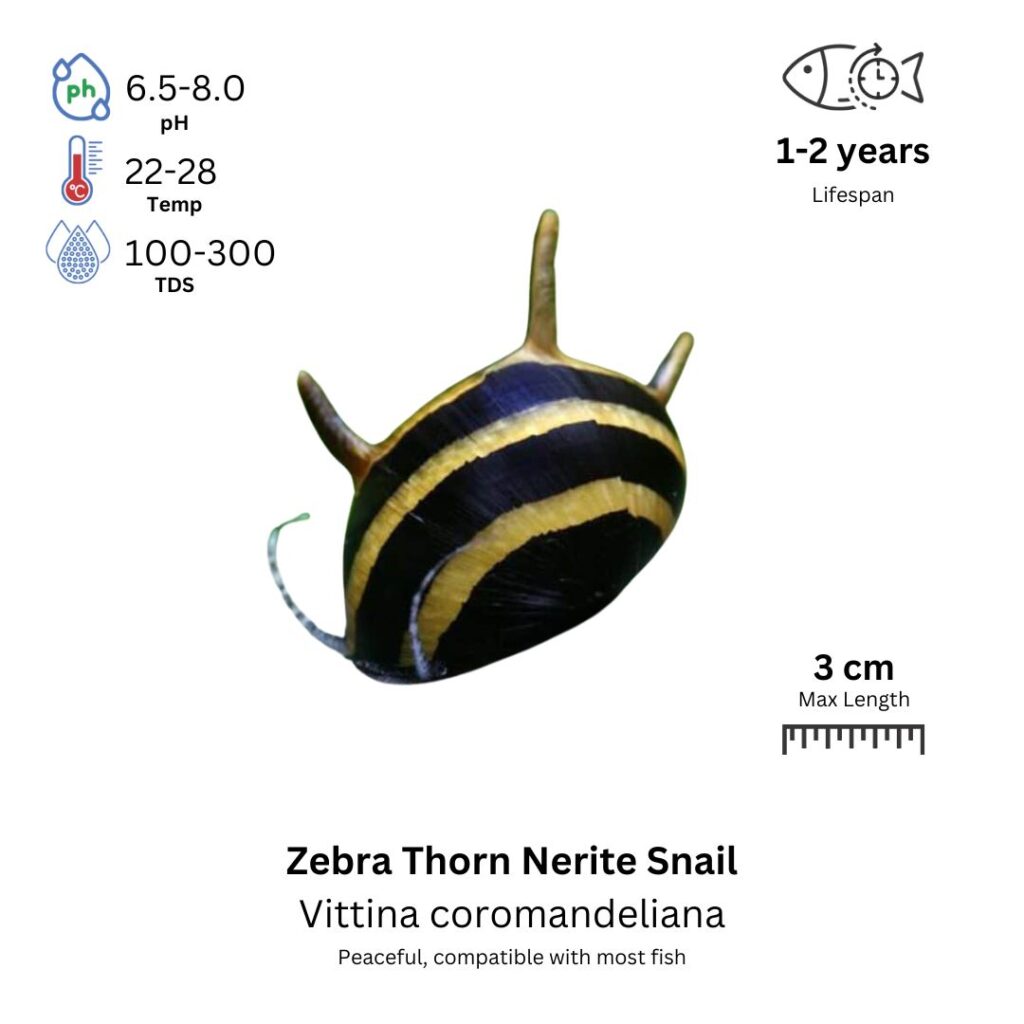Zebra Thorn Nerite Snail
Neritina natalensis (varietas Zebra)

Description
The Zebra Thorn Nerite Snail is a striking and unique freshwater snail known for its beautifully patterned, spiral-shaped shell that is typically black and yellow or brown, resembling a zebra pattern. The shell is also adorned with “spines” or “thorns,” which give the snail its “thorn” name. These snails have a relatively small, compact body, and their coloration provides a bold contrast in aquariums, especially against dark substrates or lush plants. They are peaceful, slow-moving creatures, primarily grazing on algae and detritus, helping to keep tanks clean. Zebra Thorn Nerite Snails are also well-regarded for being excellent algae eaters.
Habitat Origin
Native to freshwater rivers and streams in Southeast Asia, particularly found in areas like the Philippines, where they live in slow-moving, clean waters with plenty of algae.
Aquarium
Ideal Number in Aquarium: 1 or more individuals, as they are slow-moving but will thrive in small groups or alone.
Favorite Food

Zebra Thorn Nerite Snails are primarily algae eaters and will feed on a variety of algae types, including green, brown, and red algae. They also consume detritus, leftover food, and biofilm. In the absence of algae, they will enjoy supplementary feeding with algae wafers or blanched vegetables, such as zucchini or spinach. A calcium supplement (like cuttlebone or calcium blocks) can also help support their shell health.
Behavior:
Zebra Thorn Nerite Snails are peaceful and non-aggressive. They are slow-moving creatures and tend to spend most of their time crawling along tank surfaces, scraping algae off rocks, substrate, plants, and decorations. Their unique “thorny” shell makes them an interesting addition to an aquarium. While they can be active at all times of day, they are most often seen grazing during the day. They are generally very calm and won’t disturb plants or other tankmates.
Special Care:
These snails require a stable environment with clean, well-maintained water conditions. As they are sensitive to copper, care should be taken when using any copper-based medications in the tank. Additionally, because they rely on algae for a significant portion of their diet, providing enough natural algae growth or supplementing their diet with algae-based foods is important. They also need access to calcium to maintain a healthy, strong shell.
Compatibility with Other Fish:
Yes, Zebra Thorn Nerite Snails are ideal for peaceful community tanks with small fish, shrimp, and other snails. They are excellent tankmates for other peaceful species, as they do not engage in aggressive behavior. However, they should be kept with species that won’t harm them or cause stress, as they are vulnerable to large, aggressive fish. These snails are safe with plants and will not damage them.
Breeding Tank Setup
While Zebra Thorn Nerite Snails can breed in a community tank, using a dedicated breeding tank improves control over water parameters and egg survival. A 10-gallon tank (38 liters) is sufficient for a small group, but 20 gallons (75 liters) or more is recommended for larger colonies. Ideal water conditions include a pH of 7.0–8.5, temperature 22–28°C (72–82°F), and hardness 6–12 dGH. Use a gentle sponge or internal filter to maintain clean water with soft circulation. A sand or fine gravel substrate, along with plants like Java moss or Anubias, helps mimic natural habitats, although snails won’t lay eggs directly on plants.
Conditioning for Breeding
Condition your snails with a diet that supports both reproductive health and shell strength. Offer algae wafers, blanched vegetables (zucchini, spinach, carrots), and calcium sources such as cuttlebone or calcium blocks. Calcium is especially important for shell development. Perform weekly 20–30% water changes, and to trigger breeding, a 50% water change with slightly warmer water may help induce spawning under the right conditions.
Spawning Process
Spawning typically occurs when water parameters are stable and optimal, and is more common during warmer months. Females lay hundreds of small white or yellowish eggs in clusters on tank walls, rocks, or decorations. There is no need to separate the parents, as they do not harm their own eggs or offspring. The eggs are calcified and remain fixed to surfaces throughout development.
Fry Development
Eggs hatch in 2–3 weeks, depending on temperature. Once hatched, baby snails feed on biofilm and algae naturally occurring in the tank. If needed, supplement their diet with finely crushed algae wafers or infusoria. Maintain excellent water quality by doing frequent, small water changes (10–20%) every few days. Avoid overfeeding to prevent ammonia spikes, and keep the temperature steady within the ideal range.
Additional Notes & Tips
Zebra Thorn Nerite Snails reach sexual maturity at about 1 year of age. They are difficult to sex visually, as males and females appear nearly identical—though behavioral observation during mating may help. Avoid rapid shifts in temperature, pH, or salinity, and ensure no aggressive tank mates are present. Overcrowding can degrade water quality, so maintain a manageable snail population for healthy, successful breeding.
